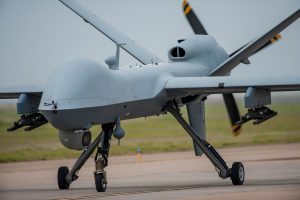The Nagorno-Karabakh clashes have once again brought the question of the efficacy of unmanned aerial combat vehicles (UACVs) in warfare to the fore. Aided by impressive photos of Armenian tanks and artillery positions being decimated by Azerbaijan’s drones, many have argued that it illustrates the changing character of war, and increasing pressure on mechanized forces from up above, especially in the absence of air superiority. Others, including The Diplomat’s new defense contributor Jacob Parakilas, point out that the “tanks versus drones” debate is much more complicated than the way in which it is often presented. India, too, has followed the Armenia-Azerbaijan conflict closely, its forces trying to infer lessons as they seek to induct UACVs.
Commenting on the use of drones in the Nagorno-Karabakh clashes, in answer to a query from the Economic Times, India’s Air Chief Marshal RKS Bhadauria, noted, “drones are an important part for surveillance and intelligence gathering. Their role in the build up to a conflict is very important. However, once the conflict starts, they do become susceptible to enemy action…” As the Indian air force chief reminded that newspaper, India, like Azerbaijan, has possessed loitering munitions (colloquially, suicide drones) for more than a decade. It should be noted that during the recent Nagorno-Karabakh clashes, Azerbaijan has fielded the Turkish-designed Bayraktar TB2 drone responsible for some of the dramatic footage of kills.
Bhadauria’s comments are especially pertinent as India discusses the purchase of armed as well as unarmed drones from the United States. In July of this year, the Trump administration tweaked an existing export control denial regime to allow the sale of drones flying at speeds of less than 800 kilometers per hour, paving the way for their sale to India. While the U.S. had approved the sale of 30 unarmed SeaGuardians (the naval variant of General Atomics’ Predator-Bs), an Indian press report suggests that the U.S. remains wary of Predator-B sales to India given fears that the technology could be leaked to Russia through “system of systems” issues.
This report also notes that the Indian Army remains in favor of acquiring armed Reapers (another moniker for Predator-Bs) against the Navy’s preference for 22 SeaGuardians. The SeaGuardians are also expected to bolster India’s anti-submarine warfare efforts, especially given its demonstrated ability to dispense sonobuoys, along with other intelligence-surveillance-reconnaissance missions through a maritime Automatic Identification System.
With the 2018 signing of the U.S.-India Communications Compatibility and Security Agreement – which facilitates secure exchange of military information and data – India and the U.S. in principle could coordinate their maritime domain awareness (MDA) activities through SeaGuardians, just like the agreement leads to greater MDA coordination using the P8 surveillance aircraft which India possesses as well. On top of that, should both countries conclude the geospatial intelligence Basic Exchange and Cooperation Agreement later this year, as expected, India could leverage it through the acquired Reapers to improve the accuracy of their targeting and kills.
Recent Indian news reports also suggest India, following the ongoing standoff with China in Ladakh, is also planning on acquiring more Heron surveillance drones from Israel, while planning to arm around 90 already in service. Israel remains the leading supplier of surveillance drones to India. India has also pushed forward the indigenous Rustom-2 surveillance drone trials following the Ladakh crisis, a significant upgrade from Rustom-1 first flown in 2010.
While much of the discussion around India’s acquisition of drones, their features as well as numbers, will now be determined by budgetary constraints following the COVID-19 pandemic as well as, to a much lesser degree, the lessons from the Nagorno-Karabakh clashes (or lack thereof), what is interesting is that there are already lingering questions about the efficacy of armed drones for India given the capabilities of its adversaries. Beyond the well-known issue that UACVs are best suited for relatively uncontested operational environments and minimal air defenses – which is certainly not something Pakistan or China provides – lies a political question around escalation control.
To wit: Despite the Indian media gushing about the role of a Reaper in the U.S. assassination of Iranian Quds Force commander Qasem Soleimani in Baghdad in January (the implication being that should India also procure them, it too would be able to launch such operations against Pakistan-based elements), the fact of the matter is that, as far as Pakistan is concerned, it would not matter if India uses a drone or a fighter jet to target individuals or groups on its territory. It would react in similar ways to both. (Writing in these pages in January after the Soleimani kill, I concluded that India simply didn’t have a Soleimani-type option when it came to Pakistan, for a variety of reasons.)
It is true that UACVs remove one crucial equation from the risk calculations behind an airstrike scenario – the possibility of a pilot being killed or captured, as was the case with an Indian fighter pilot in February last year. But by the same token, that could incentivize the use of an Indian armed drone capabilities against Pakistan, generating significant escalation risks. At the same time, China has continued its pursuit of counter-drone capabilities including those based on electronic warfare, along with other capabilities. It is therefore unlikely that an Indian UACV capability would make a significant difference in a conflict with China.
What could matter to India is a pursuit of smaller armed drones, like the nine-meter long XQ-58 Valkyrie, operating as a swarm as “loyal wingmans” to human-operated jets. As analyst Paul Scharre, in describing the benefits of cooperative drone-swarming put it, “it allows you to build large numbers of low-cost expendable agents that can be used to overwhelm an adversary.” “This reverses the long trend of rising aircraft costs and reducing quantities.” Alas, these are still experimental technologies far beyond the reach of India’s extremely limited military-industrial base.

































